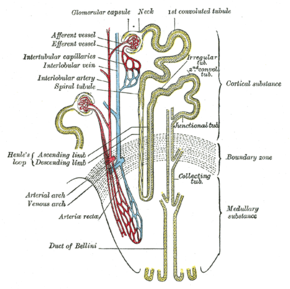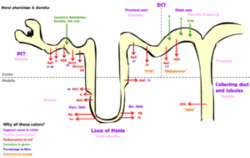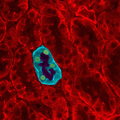كليون
| ||||||||||||||||||||
| ||||||||||||||||||||
كليون وحدة كلوية أو نفرون Nephron (من اليونانية νεφρός - nephros، وتعني "كلية") هي وحدة تركيبية ووظيفية رئيسية في الكلى. ويشكل النفرون وحدة وظيفية مستقلة وتحتوي الكليتان معاً حوالي 2 مليون نفرون لاتستطيع الكلية تشكيل نفرونات جديدة . ولهذا السبب يحدث مع أذية الكلية ( بسبب مرض او بسبب التقدم في السن ) نقص تدريجي في عدد النفرونات يتناقص عدد النفرونات العاملة عادةً بعد سن الأربعين بمعدل 10% كل 10 سنوات يعني أنه في عمر الثمانين يملك معظم الناس عدد من النفرونات العاملة أقل بحوالي 40% من الموجود عند الذين أعمارهم 40 سنة
يتألف كل نفرون بشكل رئيس من :
أنواع الكليونات
هناك صفان عموميان للكليونات هما كليونات قشرية وjuxtamedullary nephrons, both of which are classified according to the location of their associated renal corpuscle. Cortical nephrons have their renal corpuscle in the superficial renal cortex, while the renal corpuscles of juxtamedullary nephrons are located near the renal medulla. The nomenclature for cortical nephrons varies, with some sources distinguishing between superficial cortical nephrons and midcortical nephrons.[1]
التشريح
كل نفرون يتشكل من مصفاة أولية أساسية (الجسيم الكلوي ) وأنابيب صغيرة متخصصة بإعادة الامتصاص ( نبيب كلوي ).الجسيم الكلوي يرشح كمية كبيرة من السوائل خارج الدم
, delivering water and small solutes to the renal tubule for modification.
الكبيبة الكلوية Glomerulus
يصل الدم إلى الكبيبة عبر الشرين الوارد Afferent arteriole ويغادرها عبر الشرين الصادر Efferent arteriole الكبيبة الكلوية هي عبارة عن شبكة من الشعيرات الدموية المتفرعة فيما بينها قد يصل عدد التفرعات إلى 50 تفرعاً متوازياً تحاط هذه الشعيرات بمجملها بوساطة محفظة بومان يؤدي الضغط الدموي في الكبة على إلى رشح السائل إلى محفظة بومان ثم ينتقل السائل الراشح إلى النبيب
النبيب الكلوي
| ' | |
|---|---|
| Identifiers | |
| MeSH | D009399 |
| FMA | 17640 |
| المصطلحات التشريحية | |
هو عبارة عن أنبوب طويل تتحول فيه السوائل الراشحة إلى بول وذلك في اثناء سير هذا السائل باتجاه الحويضة الكلوية
ويتكون النبيب الكلوي من:
الوظائف
إن الوظيفة الأساسية للنفرون تصفية المصورة الدموية من المواد غير المرغوب بها في أثناء عبورها الكلية ومن أهم المواد التي يتم التخلص منها:
- نواتج ااستقلاب النهائية ( كاليوريا والكرياتينوحمض البول والبولات )
- المواد التي تميل إلى التراكم في الجسم بكميات كبيرة ( شوارد الصوديوم والبوتاسيوم والهيدروجين و الكلور) حيث يقوم النفرون على تصفية المصورة من هذه الشوارد
آلية الرشح وعود الامتصاص
يرشح نحو خمس المصورة الدموية من الغشاء الكبيبي إلى الجهاز النبيبي للنفرون في أثناء عبورها الكبيبات يعاد امتصاص المواد المطلوبة (خاصة الماء والشوارد) حيث يعاد امتصاص معظم الماء وكمية كبيرة من الشوارد في اثناء عبور السائل الراشح من الكبيبات إلى النبيب الكلوي حيث تضاف هذه المواد إلى المصورة الموجودة في الشعيرات حول النبيبات بينما تبقى المواد غير المرغوبة في النبيبات ليصار طرحها مع البول
نظام جمع القنوات
يتم بهذه الآلية إفراز بعض المواد مباشرة من المصورة الموجودة في شبكة الشعريات حول النبيبات إلى النبيبات وهكذا يتركب البول المتشكل من قسمين : مواد مترشحة ومواد مفرزة
Each distal convoluted tubule delivers its filtrate to a system of collecting ducts, the first segment of which is the collecting tubule. The collecting duct system begins in the renal cortex and extends deep into the medulla. As the urine travels down the collecting duct system, it passes by the medullary interstitium which has a high sodium concentration as a result of the loop of Henle's countercurrent multiplier system.
Though the collecting duct is normally impermeable to water, it becomes permeable in the presence of antidiuretic hormone (ADH). ADH affects the function of aquaporins, resulting in the reabsorption of water molecules as it passes through the collecting duct. Aquaporins are membrane proteins that selectively conduct water molecules while preventing the passage of ions and other solutes. As much as three-fourths of the water from urine can be reabsorbed as it leaves the collecting duct by osmosis. Thus the levels of ADH determine whether urine will be concentrated or diluted. An increase in ADH is an indication of dehydration, while water sufficiency results in low ADH allowing for diluted urine.
Lower portions of the collecting organ are also permeable to urea, allowing some of it to enter the medulla of the kidney, thus maintaining its high concentration (which is very important for the nephron).
Urine leaves the medullary collecting ducts through the renal papillae, emptying into the renal calyces, the renal pelvis, and finally into the urinary bladder via the ureter.
Because it has a different origin during the development of the urinary and reproductive organs than the rest of the nephron, the collecting duct is sometimes not considered a part of the nephron. Instead of originating from the metanephrogenic blastema, the collecting duct originates from the ureteric bud.
Juxtaglomerular apparatus
The juxtaglomerular apparatus is a specialized region of the nephron responsible for production and secretion of the hormone renin, involved in the renin-angiotensin system. This apparatus occurs near the site of contact between the thick ascending limb and the afferent arteriole. It contains three components: the macula densa, juxtaglomerular cells, and extraglomerular mesangial cells.
الأهمية السريرية
Because of its importance in body fluid regulation, the nephron is a common target of drugs that treat high blood pressure and edema. These drugs, called diuretics, inhibit the ability of the nephron to retain water, thereby increasing the amount of urine produced.
معرض الصور
Glomerulus is red; Bowman's capsule is white.
- Nephron structure.png
انظر أيضا
المصادر
وصلات خارجية
- Science aid: Kidney Nephron About the kidney nephron for teen understanding.
- Why Do We need Kidneys? A Whistlestop tour of renal physiology for medical students.





